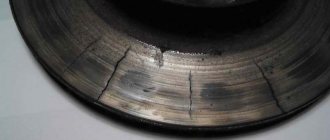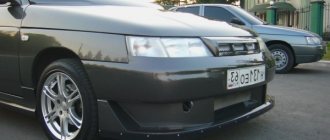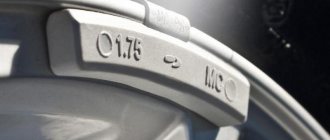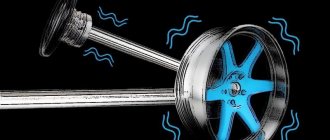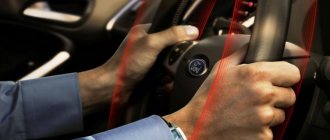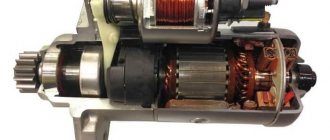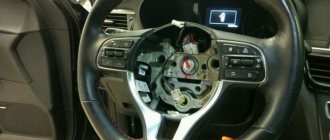The essence of the problem is this: today I was driving on business in the evening, on a flat and smooth road, over a bridge. the speed was about 100-110, and suddenly the steering wheel began to shake. vibration in the body. as if the wheel had broken. has stopped. the wheels are ok. Moreover, from a hundred I gradually dropped to 60-70, I couldn’t stop right away, because the bridge. With grief I reached the place, keeping the speed in the region of 40-60, the vibration was felt, but not as strong as at first. Two hours later I was getting ready to go back, there was zero vibration at speeds up to 90, I didn’t accelerate it higher. I drove off, after 10 minutes the vibration started again, at first small, and after 20-25 kilometers it became stronger and at a lower speed (about 40) What could be the problem? The car is of this year, mileage 10,500.
I can offer several options: 1. The wheel nuts are not tightened properly. Try to stretch it out. It was like that myself. I forgot to tighten one wheel when I changed to summer shoes, and on the bridge it began to pound so hard that it became scary. I couldn’t stop either, I drove off the bridge, stood up, looked, picked up my jaw, took out the spray bottle, held it out, thought about life. 2. The disk is bent. Usually the inner side is wrinkled, remove the wheels and inspect. Maybe something with the rubber... 3. Wheel bearings (less likely, usually does not hit) 4. Steering rods (tips) or balls. Check that the steering wheels are in a standing position (we roll the wheel left and right (left towards you, right away from you and vice versa)). Ball wheels - hang them up, preferably on a lift, swing the wheel as in the previous case, only up and down. 5. The brake discs were deformed (I drove into a puddle after intense braking). But then the beating would only occur during braking and would be felt on the pedal... 6. Rake (unlikely). When standing, shake the steering wheel, it’s normal - no knocks, etc. there should be no sounds. 7. Check the tightness of the steering knuckle fastenings to the strut and, in general, all connections in the front suspension (fastening the lower arm, etc.). It seems like everything I could come up with...
Wheel imbalance
This is one of the most common causes of steering wheel wobble at speed. If one or more wheels are not balanced according to requirements, the driver will constantly feel at speed that the steering wheel vibrates a little. Moreover, in such a situation, runout can occur at both low and high speeds, and can also be constant.
Very often there is a beating of the steering wheel when the engine reaches a certain speed. As a rule, this is explained by the fact that the load in the wheels of the car is shifted for balancing and unauthorized alignment occurs. When the engine slows down, the problem disappears by itself.
For understanding, let's give an example of a centrifuge from a regular washing machine. If the clothes inside are placed incorrectly and unevenly, then when the speed increases, strong vibration will occur, which disappears at high speed. The fact is that centrifugal force comes into play and normalizes the center of gravity, and the things inside are distributed independently. The same can be said about a car.
The solution to this problem of runout is to visit a service station and have the wheels balanced. It should be noted that before embarking on such a procedure, wash the discs well, since if there is dirt on them during balancing, its effect will soon fade away. Also pay attention to the condition and position of the weights, which should be close to each other on each side.
content .. 49 50 51 52 ..Lada Granta (2020). Steering wheel runout
Causes of steering wheel beating
Steering wheel wobble, which can occur both at high speeds and when the car is parked with the engine running
Steering wheel vibrations should never be ignored, as they may indicate a serious malfunction that jeopardizes the safety of the driver and his passengers. As soon as you notice the beating of the steering wheel, you should immediately begin searching for the cause. To begin with, find out at what speeds the “sore” manifests itself.
Steering wheel wobble at speeds of 70-100 km/h most often indicates a problem with the wheels. In winter, it can occur due to snow sticking to the wheel rim - say, after washing a car. Over time, snow masses turn into ice, which unbalances the wheel and causes vibrations in the steering wheel. However, imbalance can occur for another reason. Therefore, even if there is no ice on the disks, it still makes sense to look at the service station.
Another common cause of steering wheel wobble is severe wear on the front brake pads or rotors. In such cases, vibrations in the steering wheel appear, logically, during braking. Check the condition of the consumables: if the problem really lies there, then you know how to fix it. And if not, then move on to the next point - steering diagnostics.
Wear of the tips and wear on the steering rods can also cause the steering wheel to beat. And if, in addition to vibrations, you also notice an increase in the free play of the steering wheel, then most likely the problem is the wear of the steering rack. You cannot put off solving the problem for a long time, because gradually the play will begin to increase, and car control will noticeably deteriorate.
Other most common causes of steering wheel wobble at speed include a “bump” on one of the wheels, damage to the wheel rim, wear on the ball joint, loose wheel bolts, and even wear and tear on the driveline, the mechanism responsible for transmitting torque between the shafts.
If vibrations in the steering wheel appear exclusively in a parking lot, when the car engine is running, then it makes sense to check the mounting of the motor to the car body. In other words, engine mounts. By the way, sometimes the cause of suspicious vibrations in the steering wheel is even a defect in the spark plugs.
Be that as it may, try not to put off resolving the issue for too long. Let us repeat, this is a direct threat to the safety of you and those around you.
Vibration of the steering wheel at speed is a clear sign of a certain defect in the car. Do not delay in diagnosing and eliminating identified faults in order to prevent serious consequences that could lead to an emergency. Reliable operation of the steering system ensures the absence of any “jitters” and “oscillations” transmitted to the driver’s hands when the vehicle is moving on a flat road with a high-quality surface.
Faulty wheels and rims
If the steering wheel begins to vibrate while the car is stationary with the engine running, the problem is clearly related to the engine (the fasteners are loose or are not installed correctly after dismantling), usually appearing on cars older than 10 years. Additionally, you can check the steering column to look for other defects; in this case, it is not worth wasting your time. Repairs should be carried out as soon as possible to avoid serious damage.
If “beating” occurs at low (up to 40 km/h) speeds and disappears after further acceleration, you should pay attention to the presence of: - Snow. -Naledi. -Mud.
On the rims and in the arched spaces of the wings. This problem usually occurs in winter and after operating the car on polluted road sections or rough terrain during the spring and autumn thaw. Cleaning, washing with a Karcher or thawing in a box will eliminate the defect and eliminate vibration.
Vibration occurs when driving at speeds of 60 km/h and above. It may mean a lack of wheel balancing during their seasonal replacement or after repair - the most common reason. As the speed increases, the centrifugal force on the wheels increases. The difference in its values between the wheels leads to “beating” of the steering column. Prolonged operation with this defect can lead to failure of the bearing, which is replaced on most cars as an assembly with the hub, and repairs are not cheap.
Violation of the geometry of the disks (especially stamped ones) will cause vibration of the steering wheel, which will increase in proportion to the acceleration of movement. The geometry change problem can occur when:
-Physical impact (impact) on the wheel due to falling into a hole or hitting an obstacle. -Manufacturer defect or damage during installation.
It is not always possible to identify a defect visually, even for professionals. The inside of the disc may be damaged. To fix this, contact a tire repair shop.
A particularly common cause of steering wheel wobble among inexperienced car enthusiasts is a banal difference in tire pressure and uneven tire wear as a result of:
-Factory defect or low quality. -Operating a vehicle on bad roads or rough terrain. -Unbalancing the camber and toe of the front pair of wheels.
Regular pressure checks, high-quality maintenance and timely replacement of old tires with new ones are an effective preventive measure to prevent steering wheel vibration.
Mounting and suspension faults
When installing non-original wheel rims on your car, you should keep in mind that this factor can cause vibration in the steering column. The discrepancy between the diameters of the holes for fastening to the hub and the bolts in it causes the effect of “dangling” of the wheel, which increases with increasing speed and transmits vibrations to the hub and steering. In this case, the wheels should be replaced with “original” ones, no matter how much you like them and how much they do not fit with the car’s tuning.
Disc distortion due to improper bolt tightening:
-Uneven force during installation. - Loosening of fastening during operation. -Lack of a specified amount of fasteners.
In this case, vibration in the steering wheel will appear at high speeds and disappear when the speed decreases, but over time it will increase and become more noticeable. To fix it, just jack up the car and use a wheel wrench to check the tightness of the bolts.
Wear and failure of suspension components transmits “beating” to the steering wheel in the following cases:
-Taking sharp turns at speed - speed joints or silent blocks of the front levers, increased traction play, incorrectly set wheel pair angles. -Moving over obstacles and uneven surfaces is caused by broken steering rack bushings. - Vibrates during acceleration - the hub bearing has failed.
It is necessary to make a decision about the need to repair and replace suspension units after checking the wheels and rims.
Braking system malfunction
The appearance of “beating” of the steering wheel during braking is a sign of a malfunction of parts of the brake system. In this case, you need to check:
-Disks. -Drums. -Degree of wear and reliability of installation of linings. Premature failure of these components indicates a manufacturing defect, installation of uncertified spare parts or improper operation (overheating after prolonged braking). In this case, it is necessary to replace unusable parts with new ones and check the reliability of the brakes.
Radiator or air conditioner fan operation
A slight “shaking” of the steering wheel is possible when the electric radiator fan or air conditioner is turned on at full power. Unbalancing their mounting can cause an unpleasant effect. It is necessary to check the reliability of their installation. If the tightening becomes loose, fix the problem using a screwdriver. Clean the radiators from dirt and debris, this causes the fans to constantly operate at maximum mode.
Self-diagnosis
Determining, using a visual inspection, the exact cause of vibration of the steering wheel when driving is not immediately possible, even for professionals. To facilitate diagnostics when identifying a defect, you must:
- Drive to a section of flat and dry road that allows your car to reach a speed of up to 100 km/h. -Carry out smooth acceleration to the maximum permitted speed. -Drive 1-2 km without acceleration in this mode. -Reduce speed to minimum value.
You should pay attention to what mode of movement vibration appears, how strong it is, whether longitudinal or transverse vibrations predominate and at what moment it disappears. These are the questions that specialists will ask you when you contact a professional service center.
It should be taken into account that on some models of the Russian and Chinese automobile industry, a slight vibration on the steering wheel is acceptable by the manufacturer and only with its increasing amplitudes, it is necessary to take measures to identify the causes of the occurrence.
To more accurately identify the causes of steering wheel vibration and have it professionally repaired, you should contact a specialized auto center.
content .. 49 50 51 52 ..
Installing non-compliant drives
Trying to somehow improve the appearance of their car, many owners install some original and unusual wheels, often forgetting to pay attention to their compliance with technical parameters.
If the discs are not suitable for a specific car model, then over time this will lead to the destruction of suspension elements due to increased load, the formation of play at the joints and, ultimately, the steering wheel wobble.
Excessive contamination of the wheels also has a negative impact, which leads to their imbalance.
Hub destruction
In some situations, the steering wheel may twitch only when accelerating, while in stable motion there will be no problems. Typically, this can be caused by damage to the hub that the wheel is attached to. The reasons may be different: a strong blow or a banal failure of some element of the car’s suspension.
If steering wheel wobble when driving at speed appears during turns, then it is quite difficult to find out what the problem is, since a large number of connections and assemblies are involved in the maneuver. The reasons may be in tie rod ends, rods, bearings and much more. Any such breakdown can cause the steering wheel to jerk. Only service specialists can help and effectively fix the problem after diagnostics and inspection.
steering wheel beating VAZ-2114
Dear lovers of domestic cars, tell me how to get rid of steering wheel beats at speeds above 90 km. .
I didn’t buy a new car (2003 model year, 42 thousand kilometers), and discovered a very unpleasant thing - the steering wheel was beating. I changed the tires because the one I had (Kama), although almost new, had hernias. Now I installed Good Year, new “Astero” wheels, everything is balanced! I thought I would fly like a bird!! But no
